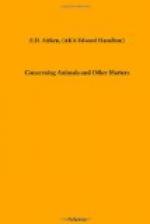XIX
BORROWED INDIAN WORDS
Of the results of the Roman supremacy in Britain none have been so permanent as their influence on our language. No doubt this was less due to any direct effect that their residence among the Britons had at the time on vernacular speech than to the fact that, for many centuries after their departure, Latin was the language, throughout Europe, of literature and scholarship. Our supremacy in India is acting on the languages of that country in both ways, and though it has scarcely lasted half as long yet as the Roman rule in Britain, English already bids fair to become one day the common tongue of the Hindus. But there is also a current flowing the other way, comparatively insignificant, but curious and interesting.
Few persons in England are aware how often they use words of Indian origin in common speech. In attempting to give a list of these I will exclude the trade names of articles of Indian produce or manufacture, which have no literary interest, and also words which indicate objects, ideas or customs that are not English, and therefore have no English equivalents, such as “tom-tom,” “sepoy” and “suttee,” I will also omit Indian words, such as “bundobust,” and “griffin,” which are used by writers like Thackeray in the same way in which French terms are commonly introduced into English composition.
Of course, it is not always possible to draw a hard and fast line. There are words which first came into England as the trade names of Indian products, but have extended their significance, or entirely changed it, and taken a permanent place in the English language. Pepper still means what it originally meant, but it has also become a verb. Another example is Shawl, a word which has lost all trace of its Oriental origin. It is a pure Hindustani word, pronounced “Shal,” and indicating an article thus described in the seventeenth century by Thevenot, as quoted in Hobson-Jobson:—“Une Chal, qui est une maniere de toilette d’une laine tres fine qui se fait a Cachmir.” With the article to England came the name, but soon spread itself over all fabrics worn in the same fashion, except the Scotch plaid, which held its own.
Somewhat similar is Calico, originally a fine cotton cloth imported from Calicut. This place is called Calicot by the natives, and may have dropped the final T through the influence of French dressmakers. Chintz is another example, being the Hindustani word “cheent,” which means a spotted cotton cloth. In trade fabrics are always described in the plural, and the Z in Chintz is no doubt a perversion, through misunderstanding, of the terminal S. Lac is another Indian word which has retained its own meaning, but it has gone beyond it and given rise to a verb “to lacquer.”




